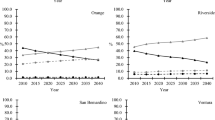Abstract
This paper describes a method for constructing projections of numbers of households of various types and the numbers of people in that structure. The method uses the concept ofhousehold size propensity, that is the probability that a person of given age and sex resides in a household of sizea, c, wherea is the number of adults per household andc is number of children per household. Using data from the 1981 and 1986 Censuses and population projections to the year 2011, the method produces projections of Australian households and household populations by size of household for five-year intervals from 1991 to 2011.
Similar content being viewed by others
References
Australian Bureau of Statistics. 1988.Year Book Australia, 1988. Catalogue No. 1301.0 Canberra.
Australian Bureau of Statistics. 1989.Census 86: Cross-Classified Characteristics of Persons and Dwellings. Catalogue No. 2498.0. Canberra.
Australian Bureau of Statistics. 1990.Projections of the Populations of Australia, States and Territories. Catalogue No. 3222.0. Canberra.
Bell, M.J. 1992.Demographic Projections and Forecasts in Australia: a Directory and Digest. Canberra: Australian Government Publishing Service.
Bell, M.J. and J.A. Cooper. 1990. Household forecasting: replacing the headship rate model. Paper presented to Fifth National Conference of the Australian Population Association, Melbourne, 19–21 November.
Cardenzana, S. and C. Ivison. 1984. Developing household projections for regions of New South Wales: some comments and observations for using the household headship rate technique. Paper presented to Seventh Commonwealth State Population Workshop, Melbourne, 18–19 October.
Cooper, J.A. 1991.Projections of Household Formation and Underlying Requirements for New Dwellings for Queensland and Statistical Divisions 1986–2011 and Selected Local Government Areas 1986–2006. Brisbane: University of Queenslan, Applied Population Research Unit.
Department of Environment, Housing and Community Development. 1977.A Method for the Projection of Households and Dwelling Completions 1975–2000. Canberra: Australian Government Publishing Service.
Indicative Planning Council for the Housing Industry. 1984.Long-term Projections Report 1984. Canberra: Australian Government Publishing Service.
Indicative Planning Council for the Housing Industry. 1989.Long-term Projections Report 1989. Canberra: Australian Government Publishing Service.
Ironmonger, D.S. 1987. Research on the household economy.Research Discussion Paper Number 1. Melbourne: University of Melbourne, Centre for Applied Research on the Future.
Ironmonger, D.S. (ed.). 1989.Households Work: Productive Activities, Women and Income in the Household Economy. Sydney: Allen and Unwin.
Ironmonger, D.S. and C.W. Lloyd-Smith. 1990. Household populations and projections of households. Paper presented to Tenth Australian Statistical Conference and Second Pacific Statistical Congress, Sydney, 5 July.
Ironmonger, D.S. and E. Richardson. 1991. Leisure: an input-output approach.Research Discussion Paper Number 16. Melbourne: University of Melbourne, Centre for Applied Research on the Future.
Jennings, V.E. 1989. Rules and the household.Research Discussion Paper Number 8. Melbourne: University of Melbourne, Centre for Applied Research on the Future.
Jennings, V.E. and C.W. Lloyd-Smith. 1992. Household change and the distribution of household size. Paper presented to Economic Society of Australia, 21st Conference of Economists, Melbourne, 10 July.
Social Policy Research Unit. 1992.Social Policy Research Unit Newsletter, No 27. Melbourne: National Institute of Economic and Industry Research.
Sonius, E. 1989. Time for kids? The impact of children on household production.Research Discussion Paper Number 7. Melbourne: University of Melbourne, Centre for Applied Research on the Future.
South Australia, Department of Environment and Planning, Development Programme Unit. 1989a.Household and Dwelling Projections for South Australia, State and Regional Projections. Bulletin 3. Adelaide.
South Australia, Department of Environment and Planning, Development Programme Unit. 1989b.Household and Dwelling Projections for the Adelaide Statistical Division 1986–2021, State and Regional Projections. Bulletin 4. Adelaide.
United Nations. 1980.Principles and Recommendations for Population and Housing Censuses. New York.
United Nations. 1989.Demographic Yearbook 1987. New York: United Nations Statistical Office.
Author information
Authors and Affiliations
Additional information
The research reported in this paper arose out of the University of Melbourne’s research program to study the structure, economics and technology of households. This research began in 1986 at the Centre for Applied Research on the Future in the Department of Architecture and Building and from 1991 has been continued by the Households Research Unit in the Department of Economics. Reports of this work are contained in the collection of essaysHouseholds Work edited by Ironmonger (1989) and in discussion papers issued by the Centre for Applied Research on the Future by Ironmonger (1987), Jennings (1989) Sonius (1989) and Ironmonger and Richardson (1991). The authors wish to thank Roger Jones of the Social Sciences Data Archive for running some cross tabulations on the 1981 Census one per cent sample tape, Vic Jennings of the Households Research Unit for his valuable contributions in a number of discussions, and the referees to thisJournal for numerous helpful suggestions.
Rights and permissions
About this article
Cite this article
Ironmonger, D.S., Lloyd-Smith, C.W. Projections of households and household populations by household size propensities. Journal of Population Research 9, 153–171 (1992). https://doi.org/10.1007/BF03029367
Issue Date:
DOI: https://doi.org/10.1007/BF03029367




